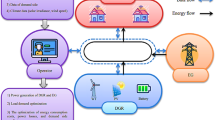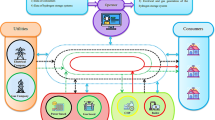Abstract
Hydro Unit Commitment (HUC) is an important problem of power systems and when it is dealt with via a mathematical programming approach and optimization, it leads to the complicated class of mixed-integer nonlinear programming (MINLP). Many attempts have been made to solve the problem efficiently, while there is still ongoing research to come up with better solution schemes in terms of runtime and optimality. Highly nonlinear nature of the relationships and constraints in the optimization problem have forced the researchers to deal with the HUC problem in simplified manners which may result in impractical and unreliable solutions, i.e. schedules. Here in this paper we proposed a new method based on sequential mixed-integer linear programming (MILP) for solving a more realistic version of the HUC problem efficiently. We applied the proposed method to a cascade of two hydropower plants, Karun-3 and Karun-4, located in the Southwest of Iran. The sequential MILP approach was compared with several MINLP solvers of the GAMS optimization package. The results indicated that the proposed methodology outperformed the MINLP solvers in terms of efficiency, with solution time of less than 30 s, compared to 10 min that were given to the solvers, and in terms of optimality with more than 20 thousand cubic meters per day in water release. Additionally, we have explored the effect of penalizing the total number of startups on the total release, convergence of the algorithm, and the computation time. In all of the cases the total number of startups was reduced more than three times.





Similar content being viewed by others
Data Availability
The code for the optimization scheme could be provided by contacting the first author.
References
Bejarano MD, Sordo-Ward Á, Alonso C, Nilsson C (2017) Characterizing effects of hydropower plants on sub-daily flow regimes. J Hydrol 550:186–200
Borghetti A, D’Ambrosio C, Lodi A, Martello S (2008) An MILP approach for short-term hydro scheduling and unit commitment with head-dependent reservoir. IEEE Trans Power Syst 23(3):1115–1124
Bussieck MR, Meeraus A (2004) General algebraic modeling system (GAMS). In: Modeling languages in mathematical optimization. Springer, Boston, pp 137–157
Catalão JPDS, Pousinho HMI, Mendes VMF (2010) Mixed-integer nonlinear approach for the optimal scheduling of a head-dependent hydro chain. Electr Power Syst Res 80(8):935–942
Cheng CT, Liao SL, Tang ZT, Zhao MY (2009) Comparison of particle swarm optimization and dynamic programming for large scale hydro unit load dispatch. Energy Convers Manag 50(12):3007–3014
Cosgrove WJ, Loucks DP (2015) Water management: current and future challenges and research directions. Water Resour Res 51(6):4823–4839
Dalsanto T, Costa AS (2016) Hydroelectric unit commitment for power plants composed of distinct groups of generating units. Electr Power Syst Res 137(16):25
Diamond S, Boyd S (2016) CVXPY: a Python-embedded modeling language for convex optimization. J Mach Learn Res 17(1):2909–2913
Finardi EC, da Silva EL (2006) Solving the hydro unit commitment problem via dual decomposition and sequential quadratic programming. IEEE Trans Power Syst 21(2):835–844
Finardi EC, Scuzziato MR (2014) A comparative analysis of different dual problems in the Lagrangian relaxation context for solving the hydro unit commitment problem. Electr Power Syst Res 107:221–229
Finardi EC, Silva ELD, Sagastizábal C (2005) Solving the unit commitment problem of hydropower plants via Lagrangian relaxation and sequential quadratic programming. Comput Appl Math 24(3):317–342
Finardi EC, Takigawa FYK, Brito BH (2016) Assessing solution quality and computational performance in the hydro unit commitment problem considering different mathematical programming approaches. Electr Power Syst Res 136:212–222
Gooi HB, Mendes DP, Bell KRW, Kirschen DS (1999) Optimal scheduling of spinning reserve. IEEE Trans Power Syst 14(4):1485–1492
Hatamkhani A, Alizadeh H (2018) Clean-development-mechanism-based optimal hydropower capacity design. J Hydroinf 20(6):1401–1418
Heredia FJ, Nabona N (1995) Optimum short-term hydrothermal scheduling with spinning reserve through network flows. IEEE Trans Power Syst 10(3):1642–1651
Hidalgo IG, Correia PB, Arnold FJ, Estrócio JPF, de Barros RS, Fernandes JP, Yeh WWG (2014) Hybrid model for short-term scheduling of hydropower systems. J Water Resour Plan Manag 141(3):04014062
Labadie JW (2004) Optimal operation of multireservoir systems: state-of-the-art review. J Water Resour Plan Manag 130(2):93–111
Lastusilta T (2011) GAMS MINLP solver comparisons and some improvements to the AlphaECP algorithm
Li X, Li T, Wei J, Wang G, Yeh WWG (2013) Hydro unit commitment via mixed integer linear programming: a case study of the three gorges project, China. IEEE Trans Power Syst 29(3):1232–1241
Li Z, Jin T, Zhao S, Liu J (2018) Power system day-ahead unit commitment based on chance-constrained dependent chance goal programming. Energies 11(7):1718
Lu P, Zhou J, Wang C, Qiao Q, Mo L (2015) Short-term hydro generation scheduling of Xiluodu and Xiangjiaba cascade hydropower stations using improved binary-real coded bee colony optimization algorithm. Energy Convers Manag 91:19–31
Mo L, Lu P, Wang C, Zhou J (2013) Short-term hydro generation scheduling of Three Gorges-Gezhouba cascaded hydropower plants using hybrid MACS-ADE approach. Energy Convers Manag 76:260–273
Mohanta RK, Chelliah TR, Allamsetty S, Akula A, Ghosh R (2017) Sources of vibration and their treatment in hydro power stations-a review. Engineering Science and Technology, an International Journal 20(2):637–648
Olsson G (2015) Water and energy: threats and opportunities. IWA publishing, London
Pereira-Cardenal SJ, Mo B, Gjelsvik A, Riegels ND, Arnbjerg-Nielsen K, Bauer-Gottwein P (2016) Joint optimization of regional water-power systems. Adv Water Resour 92:200–207
Rajan CCA (2011) Hydro-thermal unit commitment problem using simulated annealing embedded evolutionary programming approach. Int J Electr Power Energy Syst 33(4):939–946
Santos EF, Ohishi T (2004) A hydro unit commitment model using genetic algorithm. In: Proceedings of the 2004 congress on evolutionary computation (IEEE Cat. No. 04TH8753), vol 2. IEEE, pp 1368–1374
Shang Y, Lu S, Gong J, Liu R, Li X, Fan Q (2017) Improved genetic algorithm for economic load dispatch in hydropower plants and comprehensive performance comparison with dynamic programming method. J Hydrol 554:306–316
Taktak R, D’Ambrosio C (2017) An overview on mathematical programming approaches for the deterministic unit commitment problem in hydro valleys. Energy Syst 8(1):57–79
Von Meier A (2006) Electric power systems: a conceptual introduction. Wiley, Hoboken
Wang J, Zhang Y (2011) Short-term optimal operation of hydropower reservoirs with unit commitment and navigation. J Water Resour Plan Manag 138(1):3–12
Yi YJ, Zhou Y, Song J, Zhang S, Cai Y, Yang W, Yang Z (2019) The effects of cascade dam construction and operation on riparian vegetation. Adv Water Resour 131:103206
Author information
Authors and Affiliations
Contributions
Alireza Amani: Conceptualization, Methodology, Computation, Writing—original draft and review/editing.
Hosein Alizadeh: Conceptualization, Methodology, Writing—review/editing, supervision.
Corresponding author
Ethics declarations
Ethical Approval
Not applicable.
Consent to Participate
Not applicable.
Conflict of Interest
The authors declare that they have no conflict of interest.
Additional information
Publisher's Note
Springer Nature remains neutral with regard to jurisdictional claims in published maps and institutional affiliations.
Rights and permissions
About this article
Cite this article
Amani, A., Alizadeh, H. Solving Hydropower Unit Commitment Problem Using a Novel Sequential Mixed Integer Linear Programming Approach. Water Resour Manage 35, 1711–1729 (2021). https://doi.org/10.1007/s11269-021-02806-6
Received:
Accepted:
Published:
Issue Date:
DOI: https://doi.org/10.1007/s11269-021-02806-6




